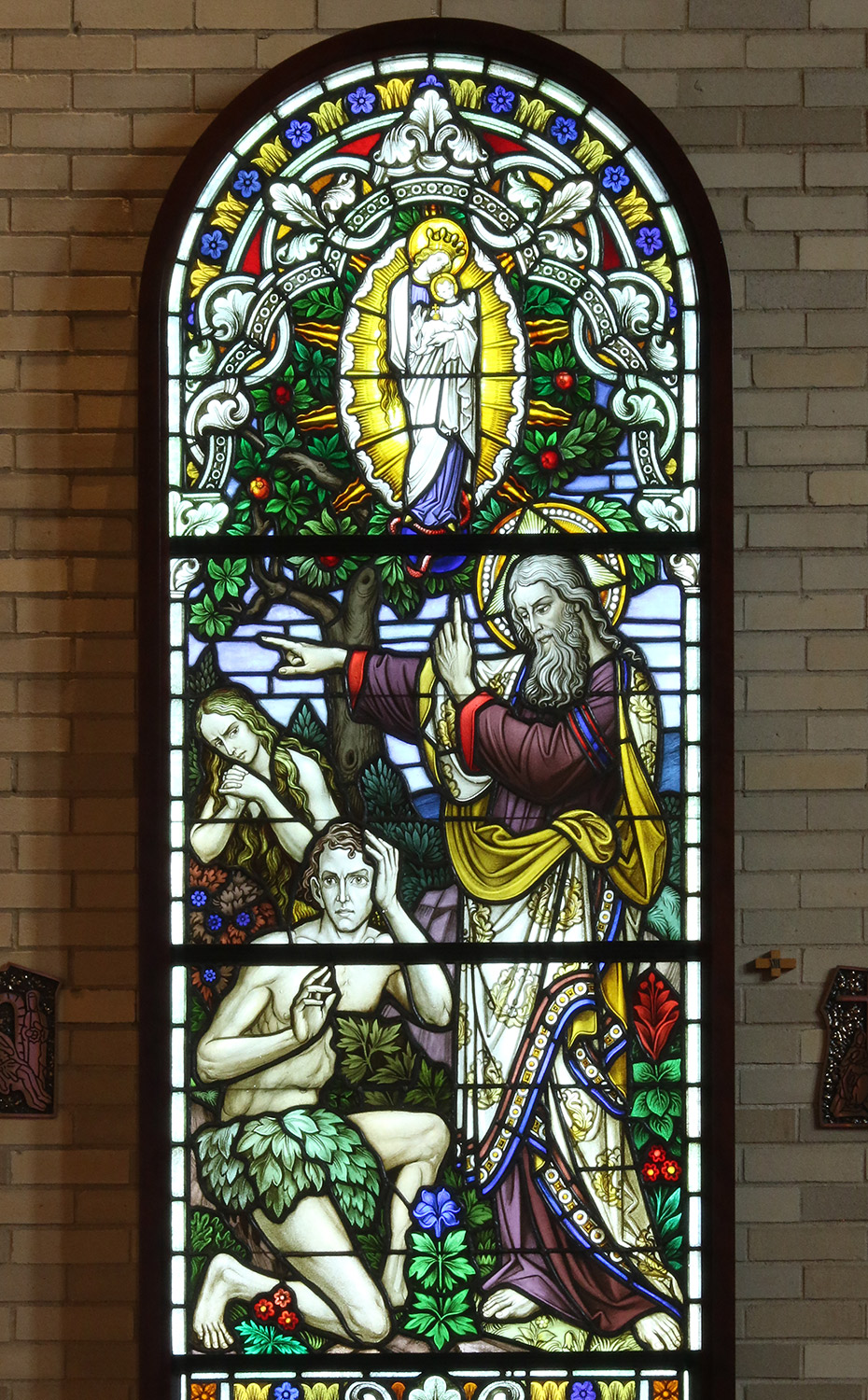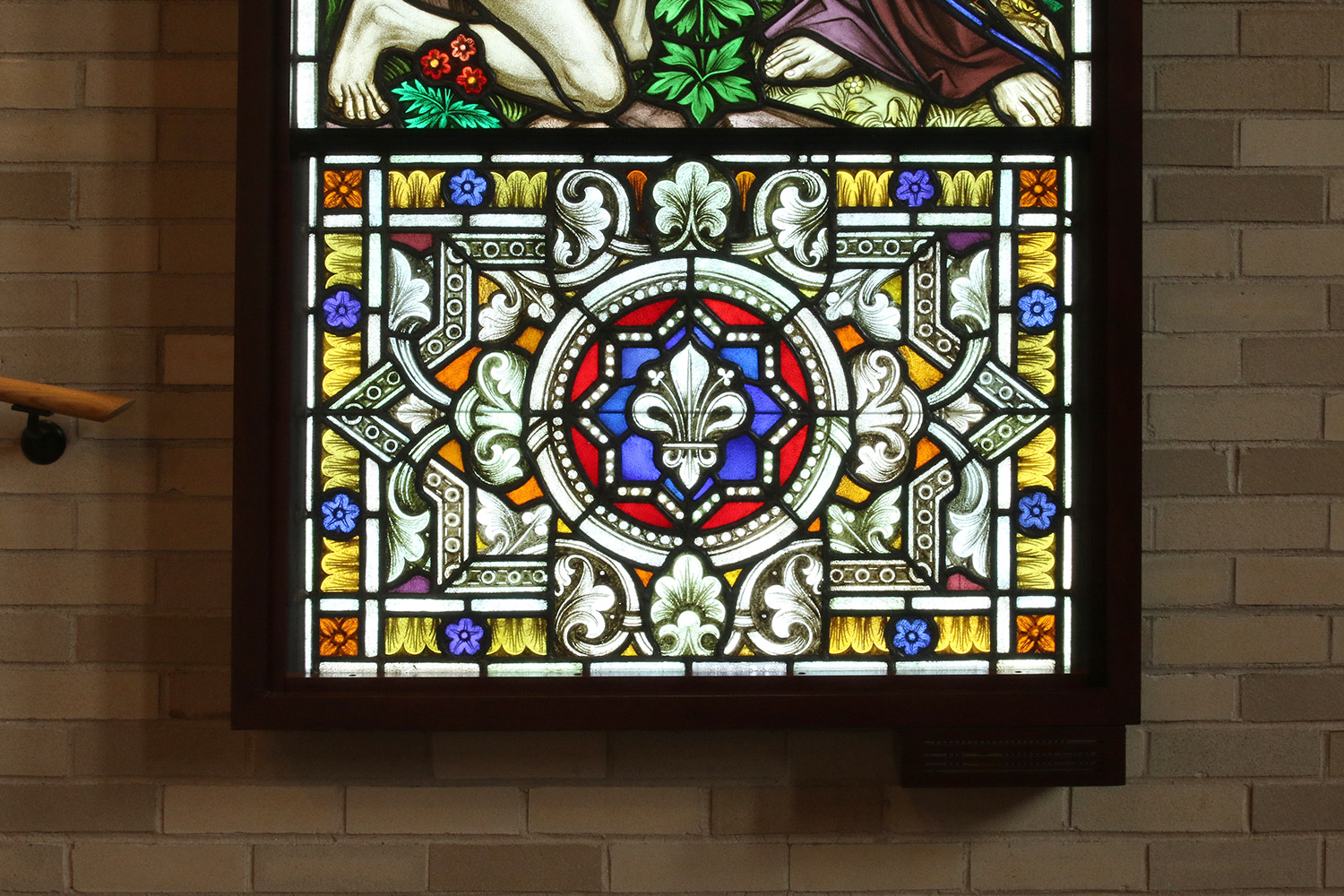From Historic Pullman to the UIC Campus:
Re-purposing Memorable Stained Glass Windows
Bernacki & Associates was privileged to fabricate display frames for beautiful historic stained glass windows and install the windows in the John Paul II Chapel at the Newman Center at 700 S. Morgan St., the spiritual home of students and faculty of the University of Illinois at Chicago. The interior of the chapel with newly installed stained glass can be viewed directly on the Newman Center’s website, www.jp2newman.org.
The original windows came from the Holy Rosary Church in the Chicago’s historic Roseland area. The beginnings of the parish date back to the times of the Pullman Car Company which manufactured railroad cars in the mid-to-late 19th century through the first half of the 20th century, during the industrial explosion of railroads in the United States. The church was founded in 1882 and was a pastoral home for the population of workers living in the historic George Pullman factory “model town.” Soon after the parish was installed, the initial, small church built outside of Pullman’s property could not accommodate the needs of the rapidly growing community of immigrant workers. Under the pressure from the Archdiocese of Chicago, George Pullman agreed that a bigger church could be built on his land with a 99-year lease. In 1890, the new church building located at the corner of today’s Martin Luther King Drive and 113th Street was dedicated. It was designed with some Romanesque Revival Style features by Solon Spencer Beman, the architect of Pullman’s factory town.
Holy Rosary remained the English-speaking territorial parish and mother parish of Pullman. It was sometimes referred to as “Holy Rosary (Irish).” During the parish’s first fifty years, there were also a small number of Polish families. The church’s windows witnessed the Pullman workers poverty and hopes, mothering the first parish school and other parishes growing in the area, the 1893 World’s Fair, workers strike of 1894, annexing the Pullman and Roseland areas to Chicago, the Great Depression lasting from 1929 to 1939, the church fire of 1937 and restoration in 1938, World Wars, economic and social changes, neighborhood changes, and parish community growth and decline in subsequent years. The church was closed in 2008. After having been part of Holy Rosary for over 100 years, the stained glass windows were carefully removed and put to storage.*
Bringing Stained Glass Windows Back to Life
At Drehobl Art Glass Co. Studio: Making size adjustments to the frame to fit stained glass panels properly
At Drehobl Art Glass Co. Studio: Adjusting frame size
To preserve the historic integrity of more than a century old stained-glass windows it is necessary to examine carefully the condition of the glass elements, lead came strips, cement between the glass and the cames, the supporting rods, and the frame. Bernacki & Associates worked with Drehobl Art Glass Co. in the process of assessment and conservation of 4 window panels. All the worn out structural reinforcement bars were removed and replaced, the parameter lead, and old cement were substituted with compatible new material, and all the cracked glass pieces were treated with appropriate repair techniques. The glass was cleaned throughout from the dirt residue.
The restored windows were fitted into display frames specifically designed and fabricated by Bernacki & Associates, Inc. The frames were built to accommodate the stained glass panels, lighting source, light defusing system, and fixtures for mounting onto the brick wall. The framed windows were installed at the eye level in the vicinity of the pews, which allowed for greater appreciation.
New Perception
The Newman Center chapel was designed in 1980 by Fox & Fox Architects and built in a short period of time as a memorial of the October 5, 1979 John Paul II’s visit to Chicago. The complex was officially dedicated just one year after this visit. The installation of the 19th century stained glass windows inside the end-of-the-20th-century’s raw style sacred interior produced a new experience to the chapel’s visitors. Apart from reviving the space through the additional source of light, the historic windows, with their carefully crafted religious images and classically rendered design, added to the interior a surprising touch of grandeur and prestige of traditional sacred places. The Holy Rosary (Irish) windows can be enjoyed again, adopted in their unpredictable new home, and connecting the present to the tradition of previous generations.
The low placement of the stained glass windows enables close and intimate encounter with delicate ornament and glory of traditional detail and craftsmanship.
Historic stained-glass windows installed amidst modern design. Note how the matching amount and temperature of light installed behind the stained-glass window panels are compatible aesthetically with the daylight coming through the actual windows.
Stained glass window and hosting frame detail.
Stained-glass window and hosting frame detail with the attached electrical box that allows access without interfering with the historic glass panels.
* Historic background information on the Holy Rosary (Irish) Church is taken from the following resources:
Koenig, Harry C., ed. A History of the Parishes of the Archdiocese of Chicago. Chicago: New World Publishing, 1980. Vol. 1, pp. 389-393.
Melvin Holli, Peter d'Alroy Jones, ed. Ethnic Chicago: A Multicultural Portrait. William B. Eerdmans Publishing Company, Grand Rapids, Michigan. Fourth edition 1995, p. 593.
Edward R. Kantowicz, To Build the Catholic City. Chicago History. The Magazine of the Chicago Historical Society, Fall 1985. Volume XIV, Number 3, pp. 8 and 11.
Archdiocese of Chicago Archives & Records Center, Holy Rosary Parish and School, pp. 1-2.














